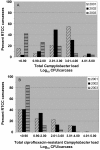Concurrent quantitation of total campylobacter and total ciprofloxacin-resistant campylobacter loads in rinses from retail raw chicken carcasses from 2001 to 2003 by direct plating at 42 degrees C
- PMID: 16085843
- PMCID: PMC1183281
- DOI: 10.1128/AEM.71.8.4510-4515.2005
Concurrent quantitation of total campylobacter and total ciprofloxacin-resistant campylobacter loads in rinses from retail raw chicken carcasses from 2001 to 2003 by direct plating at 42 degrees C
Abstract
This is the first report on the use of a normally lethal dose of ciprofloxacin in a Campylobacter agar medium to kill all ciprofloxacin-sensitive Campylobacter spp. but allow the selective isolation and quantitation of naturally occurring presumptive ciprofloxacin-resistant Campylobacter CFU in rinses from retail raw chicken carcasses (RTCC). Thermophilic-group total Campylobacter CFU and total ciprofloxacin-resistant Campylobacter CFU (irrespective of species) were concurrently quantified in rinses from RTCC by direct plating of centrifuged pellets from 10 or 50 ml out of 400-ml rinse subsamples concurrently on Campylobacter agar and ciprofloxacin-containing Campylobacter agar at 42 degrees C (detection limit = 0.90 log(10) CFU/carcass). For 2001, 2002, and 2003, countable Campylobacter CFU were recovered from 85%, 96%, and 57% of RTCC, while countable ciprofloxacin-resistant Campylobacter CFU were recovered from 60%, 59%, and 17.5% of RTCC, respectively. Total Campylobacter CFU loads in RTCC rinses ranged from 0.90 to 4.52, 0.90 to 4.58, and 0.90 to 4.48 log(10) CFU/carcass in 2001, 2002, and 2003, respectively. Total ciprofloxacin-resistant Campylobacter CFU loads in RTCC rinses ranged from 0.90 to 4.06, 0.90 to 3.95, and 0.90 to 3.04 log(10) CFU/carcass in 2001, 2002, and 2003, respectively. Overall, total Campylobacter loads of 0.90 to 2.0, 2 to 3, 3 to 4, 4 to 5 log(10) CFU/carcass, respectively, were recovered from 16%, 32%, 26%, and 5% of RTCC tested over the 2-year sampling period. For the same period, total ciprofloxacin-resistant Campylobacter loads of 0.90 to 2.0, 2 to 3, 3 to 4, and 4 to 5 log(10) CFU/carcass, respectively, were recovered from 24%, 11%, 7%, and 0.2% of RTCC tested. There was a steady decline in total Campylobacter and total ciprofloxacin-resistant Campylobacter loads in RTCC rinses from 2001/2002 to 2003.
Figures


Similar articles
-
Ciprofloxacin-resistant Campylobacter persists in raw retail chicken after the fluoroquinolone ban.Food Addit Contam Part A Chem Anal Control Expo Risk Assess. 2009 Oct;26(10):1348-53. doi: 10.1080/02652030903013294. Food Addit Contam Part A Chem Anal Control Expo Risk Assess. 2009. PMID: 21462579
-
Prevalence and numbers of Salmonella and Campylobacter spp. on raw, whole chickens in relation to sampling methods.Int J Food Microbiol. 2002 Jun 5;76(1-2):151-64. doi: 10.1016/s0168-1605(02)00027-2. Int J Food Microbiol. 2002. PMID: 12038572
-
Comparison of weep and carcass rinses for recovery of Campylobacter from retail broiler carcasses.J Food Prot. 2003 Sep;66(9):1720-3. doi: 10.4315/0362-028x-66.9.1720. J Food Prot. 2003. PMID: 14503734
-
Comparison of different sampling techniques and enumeration methods for the isolation and quantification of Campylobacter spp. in raw retail chicken legs.Int J Food Microbiol. 2006 Apr 15;108(1):115-9. doi: 10.1016/j.ijfoodmicro.2005.08.031. Epub 2006 Mar 20. Int J Food Microbiol. 2006. PMID: 16545475
-
Reduction of Campylobacter spp. by commercial antimicrobials applied during the processing of broiler chickens: a review from the United States perspective.J Food Prot. 2005 Aug;68(8):1752-60. doi: 10.4315/0362-028x-68.8.1752. J Food Prot. 2005. PMID: 21132992 Review.
Cited by
-
Fabrication and Performance Evaluation of a Novel Composite PVC-ZnO Membrane for Ciprofloxacin Removal by Polymer-Enhanced Ultrafiltration.Polymers (Basel). 2024 Dec 19;16(24):3551. doi: 10.3390/polym16243551. Polymers (Basel). 2024. PMID: 39771404 Free PMC article.
-
Swine health impact on carcass contamination and human foodborne risk.Public Health Rep. 2008 May-Jun;123(3):343-51. doi: 10.1177/003335490812300314. Public Health Rep. 2008. PMID: 19006976 Free PMC article.
-
A Historical Review on Antibiotic Resistance of Foodborne Campylobacter.Front Microbiol. 2019 Jul 26;10:1509. doi: 10.3389/fmicb.2019.01509. eCollection 2019. Front Microbiol. 2019. PMID: 31402900 Free PMC article. Review.
-
Prevalence of Campylobacter spp. in skinless, boneless retail broiler meat from 2005 through 2011 in Alabama, USA.BMC Microbiol. 2012 Aug 24;12:184. doi: 10.1186/1471-2180-12-184. BMC Microbiol. 2012. PMID: 22920043 Free PMC article.
-
Prevalence, species diversity, and antimicrobial susceptibility of Campylobacter strains in patients with diarrhea and poultry meat samples: one-year prospective study.Iran J Microbiol. 2022 Jun;14(3):362-372. doi: 10.18502/ijm.v14i3.9775. Iran J Microbiol. 2022. PMID: 37124858 Free PMC article.
References
-
- Anderson, A., J. McClellan, K. Joyce, T. Barrett, F. Angulo, and the NARMS Working Group. 2002. Fluoroquinolone-resistant Campylobacter jejuni infections in the United States: NARMS data 1997-2001. [Online.] http://www.cdc.gov/narms/publications/2002/Anderson_2002.pdf.
-
- Bren, L. 2001. Antibiotic resistance from down on the chicken farm. FDA Consumer, vol. 35, no. 1. [Online.] http://www.fda.gov/fdac/features/2001/101_chic.html. - PubMed
-
- Center for Veterinary Medicine—Food and Drug Administration. 2001. Risk assessment on the human health impact of fluoroquinolone resistant Campylobacter associated with the consumption of chicken. [Online.] http://www.fda.gov/cvm/risk_asses.htm.
-
- Centers for Disease Control and Prevention. 2000. National Antimicrobial Resistance Monitoring System (NARMS): enteric bacteria. 2000 annual report. [Online.] http://www.cdc.gov/narms/annual/2000/NARMS_final_report_2000.pdf.
Publication types
MeSH terms
Substances
LinkOut - more resources
Full Text Sources
Medical
Molecular Biology Databases
Miscellaneous

